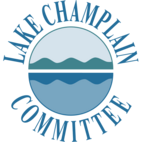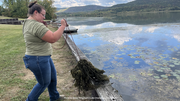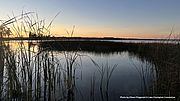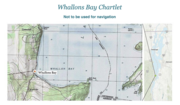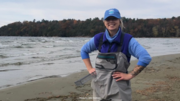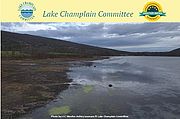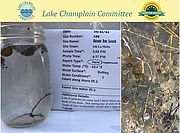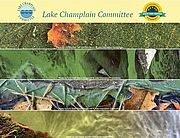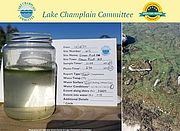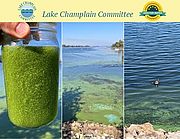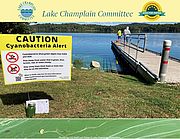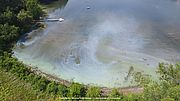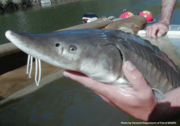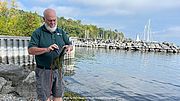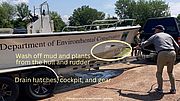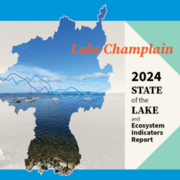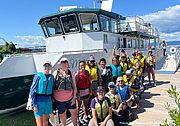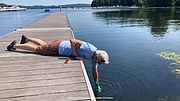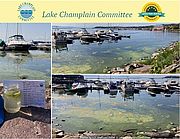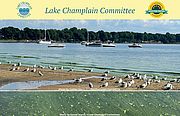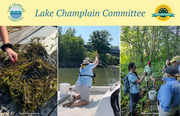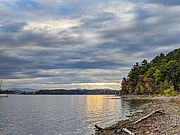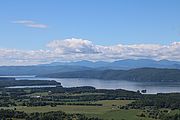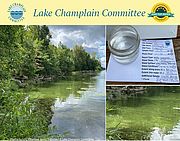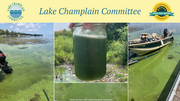On a sunny late-October day, a dual-sided rake head tied to a twenty-five-foot length of rope sailed through the air and broke the previously still water of a boat launch in Whitehall, New York with a splash. Ashley Leemans, a volunteer with the Lake Champlain Committee (LCC), reeled in the rope, and picked through the pounds of submersed plants that collected on the tines to identify what species are present. It’s a part of routine monitoring for volunteers in LCC’s Champlain Aquatic invasive Monitoring Program—CHAMP—where participants are trained to survey for invasive species, both those that have been detected in Lake Champlain and those that have been found in nearby waterbodies on the “watchlist”. While sifting through her first rake toss of the day, Ashley found something alarming. Read...
News from Selected Category
Given the recent election, national politics is on many people’s minds. Unfortunately, the protection of something as fundamental as water has become a political issue. The Clean Water Act (CWA) turned 52 in late October 2024. The Act shaped water policy in the United States and helped restore the quality of our country’s waters, but much has changed since its passage and recent court rulings have weakened its reach. Read...
Sobagwihla --soo-bah-gwee-hlah--where sea ducks gather, where it becomes ocean. That’s the Western Abenaki place name and the meaning of Kill Kare, one of the Lake Champlain Paddlers’ Trail sites. A bill that passed the Vermont Legislature in 2020 that LCC supported required that any new state park signs display both the English name and Abenaki name, if there is one. Preliminary work to identify site names was completed in October 2024 and we’ve added them to the Lake Champlain Paddlers’ Trail guidebook in recognition that the Trail exists on territory originally and currently inhabited by Abenaki and other native people. We hope to add more place names in the future. Read...
LCC welcomed Dr. Lindsey Carlson as our Water and Science Program Coordinator on 12/16/24. “Lindsey brings a wealth of experience in aquatic ecology, community engagement, and environmental science to the LCC team,” noted LCC Executive Director Lori Fisher. “We’re delighted to have her on board to oversee our cyanobacteria and aquatic invasive monitoring programs and expand the Lake Champlain Paddlers’ Trail.” Read...
They touch the tips of swimmers’ toes, wrap around fishhooks, anchors, and paddles, and form underwater meadows near shorelines—native aquatic plants are ubiquitous in Lake Champlain Basin waterbodies. The roles these aquatic superstars play in lake ecosystems are often undervalued. It is not uncommon to hear native aquatic plants described as “yucky weeds,” but they are so much more than that—each species tells their own unique evolutionary story, and each plays a role in the broader ecological and human systems of Lake Champlain. Underwater flora are frequently overlooked, yet they are as essential as trees in a forest.
Not only are these plants ecologically important—they’re beautiful! If you have a space like a gallery, library, classroom, or meetinghouse, you can add educational and artistic flair to your walls with our art prints of native aquatic plants. LCC has sets of fifteen prints showcasing the Lake Champlain flora that you can borrow for display, along with a suite of accompanying educational materials including factsheets, identification cards, informative articles, and more. Read...
In late October Lake Champlain Committee (LCC) community science volunteer Ashley Leemans tossed an aquatic rake into Lake Champlain and pulled in a clam while doing a routine monitoring check for aquatic invasive species (AIS) at the South Bay Boat Launch in Whitehall, New York. Ashley immediately reported her finding complete with photos to LCC and we followed up with the Lake Champlain Basin Program (LCBP) and state agencies who conducted further analysis and confirmed our suspicions that the mollusk was golden clam (Corbicula fluminea). The aggressive AIS has been documented in the region since 2008, but the October 2024 sighting is the first known finding in Lake Champlain. Native to the eastern Mediterranean, Asia, Africa, and Australia golden clam is hermaphroditic, meaning a single individual can start a new population. The species is known to reproduce quickly in other North American waterbodies. Read...
Reports dwindled dramatically as we moved into November and head towards the 2024 season’s end in the middle of this month.
In this email you’ll find monitoring results from 11/3 – 11/9/24, resources to help you recognize and report cyanobacteria, and photographs of leaf litter, a bloom-free Magog, murky water at Whitehall, all clear at Alburgh, and week 21 bloom-free close-ups. Read...
When a volunteer pulled a suspicious clam from the lakebed in Whitehall, New York, as part of a routine monitoring program last month, they immediately reported the find to lake scientists. Further analysis confirmed the first known occurrence of invasive golden clam (Corbicula fluminea)in Lake Champlain. The volunteer, working with the Champlain Aquatic Invasive Species Monitoring Program (CHAMP), made the discovery while conducting a survey at the South Bay boat launch. Read more about the introduction in the press release from the Lake Champlain Basin Program. Read...
In this email you’ll find monitoring results from 10/27 – 11/2/24, resources to help you recognize and report cyanobacteria, and photographs of fall beauty at Blanchard Beach, a leafy scene, Eagle Bay solitude, wind and whitecaps at Leddy Beach, Lake Bomoseen in the clear, a crayfish in the shallows at Alburgh Dunes, murky Magog, beach bubbles, and week 20 bloom-free scenes. Read...
We’re in the last few weeks of monitoring for the 2024 season with far fewer reports coming in but there are still bloom sightings so check water conditions carefully especially if you’re recreating with pets. Read...
We have a far smaller cadre of community science volunteers checking monitoring sites this time of year so while we’re still receiving bloom reports our coverage both on Lake Champlain and inland waterways is greatly reduced. Read...
Lawns make up a large portion of the developed area in the Lake Champlain Basin and simple changes to mowing and fertilizing practices can reduce stormwater runoff and pollution. Although lawn maintenance tends to wind down this season, fall is an important time to consider practices that reduce water quality impacts and can improve the health of your lawn and soil for next summer and beyond.
Read on to learn about what you can do on your lawn to support water quality! Read...
The cooler fall temperatures reduced the number of bloom sightings but we also have far fewer monitors reporting this late in the season so blooms could have been missed due to lack of coverage. Read...
Over a third of the 91 monitoring reports received for Lake Champlain during week 16 chronicled blooms--only the Main Lake South and South Lake segments had no blooms reported. Lake Carmi and Shelburne Pond also had reports of blooms. While the season is winding down, cyanobacteria can still show up long into the fall. Read...
The number of monitoring reports received for Lake Champlain fell below 100 for the first time this year during week 15 and we only received 16 reports from inland VT waterways as more volunteers and state and municipal seasonal staff left lakeside posts. Calm, dry, and relatively warm weather helped stimulate or sustain some significant blooms in Lake Champlain’s Main Lake North and Inland Sea and Malletts Bay had bloom activity as well. Read...
Aquatic plants in Lake Champlain will be dying back soon, but their blooms provide additional color to the vibrant autumn landscape. How did aquatic plants in the lake get there, and what helps make them successful away from land? We dig into the origin of plants, their journey from water to land and back again, and some specific adaptations of plants found in the Lake Champlain basin. Read...
Aquatic plants in Lake Champlain will be dying back soon, but their blooms provide additional color to the vibrant autumn landscape. How did aquatic plants in the lake get there, and what helps make them successful away from land? We dig into the origin of plants, their journey from water to land and back again, and some specific adaptations of plants found in the Lake Champlain basin.
Lake sturgeon are fish with a lot of superlatives. They have been on Earth longer than any flowering plant, can grow to the standing height of an adult man, and live to be supercentenarians in the right conditions a complicated relationship with people as it was Nearly driven to extinction and currently designated as endangered in Vermont and threatened in New York, lake sturgeon have complicated relationships with people. Read on to learn about their storied evolutionary history, “vintage” features, and how they got to the precarious state they’re in now. Read...
Aquatic invasive species (AIS) are among the major challenges facing Lake Champlain—they reduce biodiversity by outcompeting native species and disrupting ecological processes, and they can proliferate to impact water quality and recreation. LCC launched a volunteer community science initiative—the Champlain Aquatic invasive Monitoring Program (CHAMP)—to train folks how to identify and survey for key AIS in Lake Champlain. We still need volunteers to survey before the snow flies—you can sign up on our website and we’ll schedule additional trainings in your area. Read on to learn more about the program and stories from the field. Read...
Humans are the main conveyors of most aquatic invasive species, moving them from one body of water to another. Many of these troublesome plants and animals can be unintentionally transported on fishing gear, boating equipment, or even tiny amounts of water left in a watercraft. The simplest and most effective way to prevent the spread of aquatic invasives is to ensure that your vessel and all your equipment are cleaned, drained, and dried.
In June 2024 the Lake Champlain Basin Program -- the entity that coordinates and helps fund implementation of the Lake Champlain restoration and management plan in partnership with New York, Vermont, and Quebec government agencies – released its 2024 State of the Lake Report. The 36-page document provides an update on how Lake Champlain is faring according to four goals of clean water, healthy ecosystems, informed and involved public, and thriving communities. It includes a “scorecard” showing data trends on phosphorus, cyanobacteria blooms, and the introduction of new invasive species and uses easy-to-understand graphics and maps to illustrate complex issues. Read on for a brief tour of the contents and some take-aways. Read...
The Lake Champlain basin is full of stories that educators can use to teach all subjects, engage students in learning about their community, and integrate content, service, and a sense of belonging to their home watershed. To delve into these stories with teachers, the Lake Champlain Committee and our partners in the Champlain Basin Education Initiative (CBEI) hosted a course called Watershed for Every Classroom (WEC). The place-based educational program in the Lake Champlain watershed is part professional development and part summer camp for teachers. Read...
Cyanobacteria naturally occurs in lakes and have existed on earth for millions of years. Under the right conditions they form large accumulations referred to as blooms. Some types produce toxins which release into the water especially when cyanobacteria die and break down. Not all cyanobacteria blooms are toxic, but since there is no way to tell if toxins are present without laboratory tests, it is always safest to avoid blooms and adhere to beach closures—when in doubt, stay out. Read...
Blooms were observed daily during week 14 of monitoring and dominated the reports received on 9/15 and 9/20/24. A third of the reports over the seven-day period were of blooms reinforcing the importance of monitoring through much of fall and checking water conditions carefully before recreating. Read...
Hot weather at the end of week 13 helped fuel more blooms on Lake Champlain and inland waterways. When reviewing the stats for this week keep in mind that we have fewer monitors reporting this time of year, so coverage is less comprehensive. Case in point, we only received one report from St. Albans Bay but there were likely more blooms in that area during the week. Read...
Lake Champlain currently has 51 known non-native and invasive species with many more approaching—the Hudson River has over twice as many and the Great Lakes host nearly four times more. AIS pose a significant threat to ecosystem health. Early detection is key to controlling new populations before they become established—and you can help by becoming an LCC CHAMP community science volunteer! Click to learn more and sign up.
After CLF, LCC and VNRC’s petition, EPA says state of Vermont must revamp agricultural regulation. Read...
In a letter issued today to the VT Agency of Natural Resources the US Environmental Protection Agency (EPA) says Vermont falls short on Clean Water Act enforcement. The letter comes almost two and a half years after LCC, the Conservation Law Foundation (CLF), and the Vermont Natural Resources Council filed a petition asking EPA to thoroughly investigate how the state applies the Clean Water Act on farms. The issue arose from the Vermont’s Agency of Natural Resources and Agency of Agriculture both overseeing clean water regulations for farms. EPA found that Vermont does not do enough to regulate concentrated animal feeding operations – farms that keep a large number of animals confined to a small, densely populated space. Read...
Reporting dropped off dramatically during week 12 as we had fewer blooms, and many municipal and state personnel who monitor beaches left seasonal posts. Reminder that while week 12 had a fairly low incidence of blooms compared to recent weeks it is still peak bloom season and cyanobacteria can show up in any waterway. (We are seeing a bloom response to the warmer temperatures in week 13.) Read...
Blooms were dominant at the beginning of week 11 in the northeast section of Lake Champlain on 8/26 with extensive ones reported in Missisquoi Bay, St. Albans Bay, Main Lake North, and the Inland Sea. Blooms were also observed at Lake Carmi, Lake Memphremagog, Shelburne Pond, and Ticklenaked Pond and unusual pink cyanobacteria was observed at Silver Lake in Barnard VT. Read...
